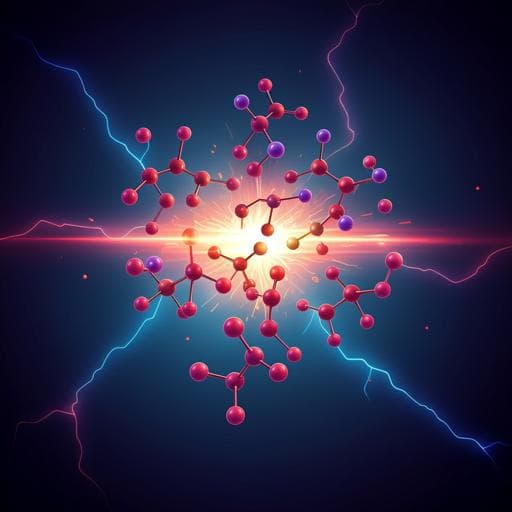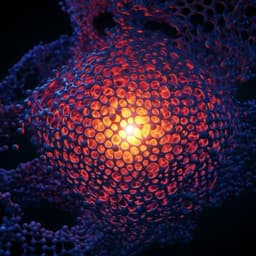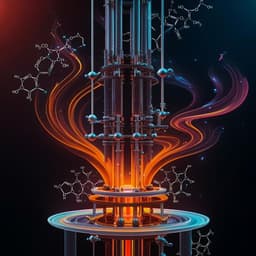
Chemistry
Electrochemical Insertion of Ammonia into Cyclic Alkenes for the Synthesis of Aromatic N-Heterocycles
S.i. and X.c.
Discover a groundbreaking electrochemical method developed by S.I. and X.C. for the direct insertion of ammonia into cyclic alkenes, enabling the synthesis of various aromatic N-heterocycles with remarkable efficiency and versatility.
~3 min • Beginner • English
Introduction
The study addresses the longstanding challenge of constructing aromatic N-heterocycles directly from alkenes without relying on pre-oxidized starting materials and oxidative cleavage methods (e.g., ozonolysis or OsO4), which restrict functional group tolerance. The authors propose that direct heteroatom insertion into carbon skeletons could offer advantages in atom/step economy, tolerance of oxidation-labile functional groups, and novel selectivity, but efficient C–C bond cleavage alternatives to oxidation are scarce. Dehydrogenation represents a complementary approach to oxygenation, and electrochemical dehydrogenative cross-coupling can forge bonds while evolving H2 at the cathode, obviating external oxidants. The central research question is whether electricity can enable direct insertion of ammonia (NH3) into alkenes to form aromatic N-heterocycles efficiently, with high atom economy and broad functional group compatibility.
Literature Review
Prior work has established electrochemical dehydrogenative cross-couplings as powerful oxidative bond-forming strategies without external oxidants. Significant advances in electrochemical C–N bond formation include aromatic C–H amination, benzylic C–H amination, alkyne amination, alkene azidation, alkane amination, aromatic C–X/N–H cross-coupling, and alkene aziridination, among others (refs. 22–60 in the article). Despite this progress, the direct electrochemical union of ammonia and alkenes to deliver aromatic N-heterocycles had not been realized. Classic synthetic routes to isoquinolines and related heterocycles often rely on oxidative cleavage of alkenes (e.g., ozone or OsO4), limiting scope and functional group tolerance. Recent electrochemical aziridinations (including with primary amines and ammonia) informed the possibility of generating aziridine intermediates electrochemically en route to aromatized products, but a general oxidant-free pathway to aromatic N-heterocycles from NH3 and alkenes remained elusive.
Methodology
Optimization: Using indene derivative 1a as model, reactions were conducted under constant cell potential with graphite felt (GF) anode and various cathodes at 0 °C. Initial conditions: MeOH solvent, Mg(ClO4)2 electrolyte (0.1 mmol in 5 mL MeOH), GF(+)/GF(−) gave 2a in 16% 1H NMR yield. Improving cathodic H2 evolution with Pt or Ag cathodes increased yields: GF(+)/Pt(−) 30%; GF(+)/Ag(−) 52%. Temperature and voltage variations affected yield (e.g., 3.5–5.0 V, −10 °C to rt), with best performance at 0 °C initially. Mixed solvent MeOH/DCM (4:1) at rt improved yield to 68% (65% isolated). iPrOH/DCM gave no reaction. LiCl performed poorly (30%), while LiBF4 matched Mg(ClO4)2 (67%). No reaction was observed using Pb(OAc)4/NH3 in a non-electrochemical attempt. General small-scale procedure: In a 10 mL three-neck heart-shaped flask, substrate alkene (0.1 mmol), Mg(ClO4)2 (22.3 mg, 0.1 mmol), GF anode (2×1×0.5 cm), Ag cathode (2×1 cm) were set up under an NH3 balloon (~1 atm) after three evacuate/backfill cycles. Anhydrous solvent (5 mL) was added and electrolysis at constant cell potential was run at room temperature, monitored by TLC/GC-MS, followed by silica gel purification. Gram-scale: In a 400 mL rectangular flask, 1a (10.0 g, 42 mmol), LiBF4 (0.60 g, 6 mmol), two GF anodes (8.5×6.5×0.5 cm and 6.5×6.5×0.5 cm) and one Ag cathode (6.5×6.5×0.5 cm) were employed; electrodes were separated and fixed. Mechanistic studies: The reaction interrupted early revealed an aziridine intermediate (9), isolated and characterized. Subjecting 9 to the electrochemical conditions afforded isoquinoline 2a; without electricity, 9 decomposed and 2a was not detected. Kinetics showed intermediate 9 peaking at ~30 min and fully consumed by ~180 min; product 2a accumulated up to ~120 min before a slight decrease. Cyclic voltammetry: 1a oxidizes more readily than NH3 in MeOH; co-presence of NH3 shifted peak potential (onset ~1.0 V vs SCE, peak ~1.5 V vs SCE), indicating NH3 influences the electrode environment. Oxidation of 1a proceeded slightly more readily than that of 9. Proposed mechanism: Four anodic electron-transfer steps with cathodic H2 evolution. Oxidation of alkene 1 forms radical cation A, trapped by NH3 to neutral radical B; second oxidation yields cation C, cyclizing to aziridine D; third oxidation at N produces intermediate E, which undergoes deprotonation/rearrangement to dihydroisoquinoline radical F; a fourth oxidation and deprotonation delivers aromatic product 2. At the cathode, two equivalents of H2 are evolved, closing the electron balance. Applications and scope: The method enables construction of diverse aromatic N-heterocycles from cyclic alkenes, including access to substituted 1,3-diazines not available by other methods. A four-step synthesis of the pharmaceutical moxaverine (2as) from indanone 4 was achieved, with the ammonia insertion step giving 62% yield. Conversion of an intermediate (7) to an unsymmetric bi-quinoline (2at) and subsequent oxidation to an axial-chiral bi-N-oxide (8) was demonstrated.
Key Findings
- Developed an electrochemical, oxidant-free dehydrogenative insertion of ammonia into cyclic alkenes to form aromatic N-heterocycles, driven by cathodic H2 evolution and avoiding external oxidants, with theoretical atom economy up to 99.2%.
- Optimized conditions included GF anode/Ag cathode, MeOH or MeOH/DCM solvent, and Mg(ClO4)2 or LiBF4 electrolyte under an NH3 balloon (~1 atm). Best model yields: 68% (1H NMR) and 65% isolated for 2a in MeOH/DCM at rt; MeOH alone reached 52% with Ag cathode.
- Reaction conditions are sensitive: iPrOH/DCM gave no reaction; alternative electrolytes (LiCl) lowered yield to 30%.
- Mechanistic evidence supports a four-electron anodic pathway featuring an electrochemically generated aziridine intermediate (9) that rearranges to the aromatic product only under electrolysis; without electricity, 9 decomposes.
- Kinetic profiling showed transient accumulation of aziridine 9 (max at ~30 min) followed by its consumption by ~180 min; product 2a accumulated for ~120 min before slight decline, suggesting subsequent side processes at extended times.
- CV studies indicate 1a is oxidized more readily than NH3; in the presence of NH3 the peak potential shifts (onset ~1.0 V vs SCE, peak ~1.5 V), suggesting NH3 influences the electrode interface during electron transfer.
- Demonstrated synthetic utility: access to substituted 1,3-diazines not attainable by other methods; application to a four-step synthesis of moxaverine featuring the ammonia-insertion step in 62% yield; construction of an unsymmetric bi-quinoline and its oxidation to an axial-chiral bi-N-oxide scaffold.
- Scalability demonstrated via gram-scale electrolysis of 1a using larger GF/Ag electrodes and LiBF4 electrolyte.
Discussion
The findings show that electricity can replace chemical oxidants to enable direct NH3 insertion into alkenes, addressing the challenge of constructing aromatic N-heterocycles while preserving oxidation-sensitive functionality. The dehydrogenative approach achieves oxidative bond formation with H2 as the sole by-product, maximizing atom economy and minimizing waste. Detection and productive conversion of an aziridine intermediate under electrolysis illuminate a mechanistic sequence of sequential anodic oxidations culminating in aromatization, rationalized by CV and kinetic data. This mechanistic framework explains functional group tolerance and suggests that controlling electrode materials, solvent, and electrolyte can tune selectivity and efficiency. The method expands the repertoire of C–N bond-forming electrochemistry to include direct NH3 incorporation, enabling streamlined access to pharmaceutically relevant scaffolds and chiral motifs.
Conclusion
A general, oxidant-free electrochemical method was established for inserting ammonia into cyclic alkenes to furnish aromatic N-heterocycles via a four-electron dehydrogenative pathway with cathodic H2 evolution and up to 99.2% theoretical atom economy. The process proceeds through an electrochemically generated aziridine that undergoes rearrangement and aromatization under continued electrolysis. The protocol tolerates oxidation-labile functional groups, is scalable, and enables concise syntheses of valuable heterocycles, including a step in the preparation of moxaverine and bi-quinoline N-oxides. Future work could broaden substrate classes (e.g., acyclic alkenes or more hindered systems), explore asymmetric variants, develop continuous-flow adaptations, and further optimize electrolytes/electrodes to enhance yields and selectivity.
Limitations
- The reaction exhibits sensitivity to conditions: solvent choice is critical (iPrOH/DCM gave no reaction), and yields vary with cathode material, temperature, and applied voltage.
- Yields for some substrates (e.g., model 2a) are moderate under batch conditions, and product yield can decrease upon extended electrolysis, indicating potential overoxidation or side reactions.
- The aziridine intermediate decomposes without electrochemical input, suggesting that continuous controlled electrolysis is required for productive conversion, which may limit operational simplicity.
- Full substrate scope and limitations are not detailed here; compatibility with diverse alkenes and functional groups beyond those shown may vary.
- The method requires handling gaseous ammonia and electrochemical equipment, which could limit immediate adoption in settings lacking such infrastructure.
Related Publications
Explore these studies to deepen your understanding of the subject.







